Summary of Paolo Uccello
Uccello's legend rests on his pioneering work in visual perspective and his skill at blending this precise mathematical approach to compositions with more decorative qualities. A life-long friend of Donatello, he was instrumental in establishing the convention of foreshortening within the Renaissance movement. But despite his progressive (some would say, radical) work in this field, Uccello's painting remained true to his training in the late Gothic tradition; especially in the way he continued to prioritize color and pageantry over the predilection for classical realism as practiced en-masse by his humanist contemporaries. History positions Uccello thus, as a vital, if somewhat paradoxical, figure within the ascendency of Renaissance art.
Accomplishments
- Uccello most famous paintings - including the Renaissance masterpiece The Battle of San Romano (c. 1456) - are exemplars of the artist's studious, almost devotional, studies in perspective. For some, however, his fixation on exploring the mathematical properties of picture composition came at the high cost. The famous Renaissance biographer Giorgio Vasari, for instance, argued (a little harshly according to some) that artists "who devote more attention to perspective than to figures develop a dry and angular style because of their anxiety to examine things too minutely".
- A student of Lorenzo Ghiberti, Uccello retained his master's love of late Gothic stylization and its focus on bold color schemes, pageantry, and luscious landscapes. He would, for instance, use gold leaf to highlight solders' armour which meant his preference (leaned in part in his early career role as a mosaicist) for the "arbitrary use of color" (as Vasari put it) saw him favor aesthetic effect over historical accuracy.
- Uccello brought his influence to bear on some of the greatest names in Renaissance art through his fastidious pursuits in picture perspective and his use of vanishing points. In particular, his sublime handling of foreshortening techniques was such that it provided the stimulus for treatises by such luminaries as Piero della Francesca, Leonardo da Vinci, and Albrecht Dürer.
- Although he had earned the reputation as a reclusive figure, and while he was condemned as something of a "radical" by the public, Uccello still earned considerable fame in his own lifetime by securing many high-profile commissions; not least for the two most important institutions in Florence: The Court of the Medici, and the Duomo (Cathedral of Florence).
The Life of Paolo Uccello
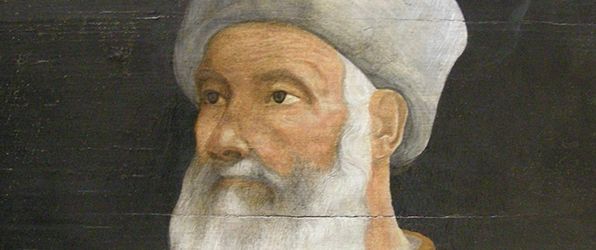
Uccello was so single minded in his pursuits of picture perspective, he became something close to a recluse: "This knowledge I pursue is the finest pleasure I have ever known", he said, and "I could no sooner give it up that I could the very air that I breath".
Important Art by Paolo Uccello
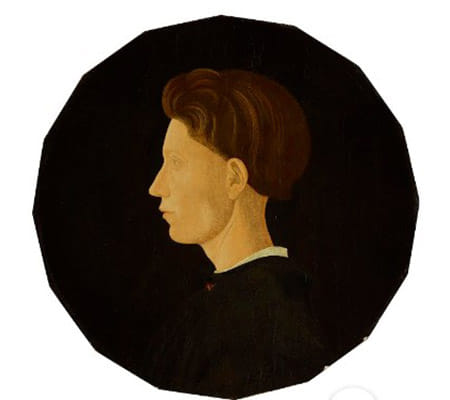
Portrait of a Young Man
This work was likely completed by Uccello in his early thirties. It is the first medal portrait that art historians can confidently put the artist's name to, and was only attributed to him following analysis of fresco medallions known to be created by the artist for the Prato Cathedral.
Giving no hint of the complex studies in perspective and color that would become his trademark, this profile portrait depicts an unnamed young man in plain black attire (and white shirt collar detail). Medal portraits such as this became popular during the Italian Renaissance as they offered wealthy patrons allusions to the era of Classical Antiquity. The Metropolitan Museum of Art finds that portrait medals fit well with the ideals of the Italian Renaissance including "the humanist emphasis on the primacy of the individual, the revival of classical antiquity, and the related desire to perpetuate personal fame and achieve earthly immortality in emulation of the great persons of the ancient world".
Uccello's decision to pose the subject in profile pre-empts one of the most famous double portraits in the history of Renaissance art, Piero della Francesca's Portraits of the Duke and Duchess of Urbino (1465-1472), an artist who took great inspiration from Uccello. While the shape of the Portrait of a Young Man today appears almost coin-like, this is likely because the portrait was cut down from its original square or rectangular shape during the nineteenth century to make for a more attractive sell.
Oil on wood - Newfields, Indianapolis
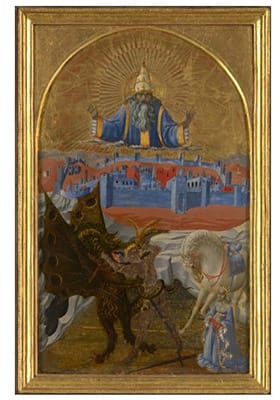
St George Slaying the Dragon
This painting, produced during the same period as Portrait of a Young Man, recounts the primary event in the legend of the third century Christian saint, Saint George. Based on the fourteenth-century story, a dragon controlled a local town and demanded residents sacrifice their children to him. When it came time for the King's daughter to be sacrificed, Saint George arrived and beheaded the dragon (thus sparing the King's daughter).
Hierarchical scale, the technique employed by artists to emphasize power based on relative size, has dictated here that God the Father be the dominant pictorial presence. When compared to God, indeed, Saint George (in gilded armour that has admittedly lost most of its sheen over the centuries) cuts a somewhat secondary figure. Whereas the villainous dragon is dark, moreover, Saint George's horse and the princess are represented in light shades, probably as a blunt means of emphasizing the good versus evil dichotomy.
While George and the dragon are engaged in a standoff on the left of the frame, to the right, we see the King's daughter flanked by George's horse. Supervising the exchange is God, shown in the form of a bearded man whose towering presence presides over events. Uccello demonstrates his interest in linear perspective in this work by positioning God at the image's vanishing point. If one follows the sightlines of his hands, the viewer can discern those elements of the painting, such as the town's towers, are farther away, while Saint George and the dragon, which are larger by comparison, appear to occupy the foreground. Close examination of the work also reveals Uccello's eye (despite Vasari's claim to the contrary) for capturing detail: from the gold leaf in God's halo; to the dragon's teeth; to Saint George's determined glare. Working in a tradition that prioritized Christian hagiography, Uccello shared an account important for contemporary worship.
Oil, tempera and silver leaf on wood panel - National Gallery of Victoria, Melbourne
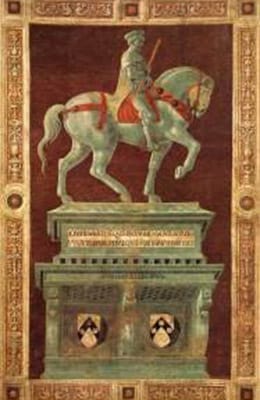
Funerary Monument to Sir John Hawkwood
Uccello's fresco gives all the appearance of an equestrian statue. Akin to actual equestrian statues that act as funerary monuments, the fresco honors Sir John Hawkwood, an English born mercenary who became a military hero to Florentines following his efforts in the fourteenth-century battle at Cascina. The fresco stands in the Florentine Cathedral (the Duomo) and was completed the same year as the Cathedral's completion (in 1436).
The artist uses a variety of techniques to accomplish his trompe l'oeil ("trick of the eye") effect. To develop the sturdy, structural appearance of the monument's base, Uccello was likely inspired by his contemporary, Masaccio, who had employed linear perspective to represent the illusion of three-dimensionality when creating his masterpiece, The Holy Trinity (1427-28).
Giorgio Vasari noted that Uccello was "gifted with a sophisticated mind, enjoyed investigating complex mechanisms and the strange products of the art of perspective". Here, for instance, Uccello used "complex" foreshortening brushwork techniques as a way of "humanizing" Hawkwood's horse. (As he demonstrated to fuller effect in his later masterpiece, The Battle of San Romano), Uccello also makes the horse's legs shorter than they would be in nature to give the animal the impression of movement. Meanwhile, the green tint, meant to evoke a copper statute, is achieved using the terra verde (green earth) technique (the terra verde method in fact dates to the medieval age, and was more widely adopted amongst humanist Renaissance artists as a way of underpainting flesh tones in green to bring out the more naturalistic red and pink flesh tones).
Before the work was unveiled to the public, the Duomo's patrons requested that Uccello overhaul his representation of Hawkwood. While it is not known what elements of the fresco displeased the patrons, generally the fresco would likely have been considered modernist for its time. As historian John T. Paoletti writes, Uccello adopted "a single-point-perspective scheme, a fully sculptural treatment of the horse and rider, and a sense of controlled potential energy within the figure [all of which] indicate Uccello's desire to assimilate the new style of the Renaissance that had blossomed in Florence since his birth".
Fresco - Cattedrale di Santa Maria del Fiore (Florence Cathedral), Florence
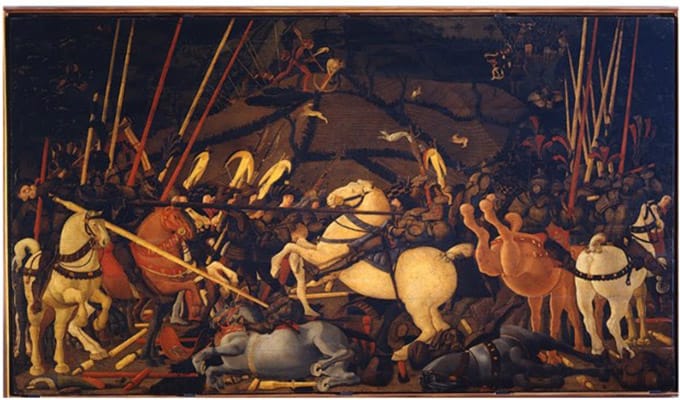
The Battle of San Romano (Niccolò Mauruzi da Tolentino at the Battle of San Romano)
Early in his career, Uccello worked in stained glass as a mosaicist in Venice, instilling in himself an appreciation for the dynamics of color. This is evident in The Battle of San Romano in which Uccello creates stark contrasts between brilliant reds, crisp whites, and ink black tones. Generally considered to be Uccello's magnum opus, The Battle of San Romano was originally presented as a triptych. Each of the three panels celebrate turning points from a significant battle in Florence's conflict with the Sienese concerning access to Pisa (which was a strategic port). This scene depicts the Florentine triumph of when the Sienese leader, Bernardino della Carda, is bested, and knocked to the ground with his horse.
The iconography of the scene is busy and complex: soldiers, horses, weapons, and nature take up almost every inch of the canvas. The cohesive feature of the painting is, however, Uccello's pioneering use of linear perspective. Each element is calculated so it can almost be traced with mathematical accuracy to meet at the vanishing point which is represented by the figure hunting a rabbit with a bow and arrow at the top of the composition. From there, the black lines in the earth lead the viewer's eye to the receding parallel lines in the scene. The lower half of the canvas resembles a grid of spears, soldiers, and horses, imposing an almost logical guide around the painting. Uccello uses the technique of foreshortening to trick the eye into believing the sense of space and scale. For instance, the rear legs of fallen Sienese leader Carda's blueish black horse are not anatomically accurate to the remainder of the horse's body. Rather, the rear legs are reduced to support the illusion that the horse's feet are closer to the viewer than the horse's head.
Uccello's figures look to us almost like puppets or dummies in a re-enactment of a medieval tournament. However, his figures - which feature fine decorative detail in the soldiers' armor, and on the horses - are fully in keeping with the "fairy-tale" iconography associated with the late-Gothic style. These features, when coupled with the naturalistic details of his receding three-dimensional background, confirms, more than any other work in his oeuvre, Uccello's status as the most important artist in the transition from late Gothic to early Renaissance art.
Tempera on panel - The Uffizi Gallery, Florence
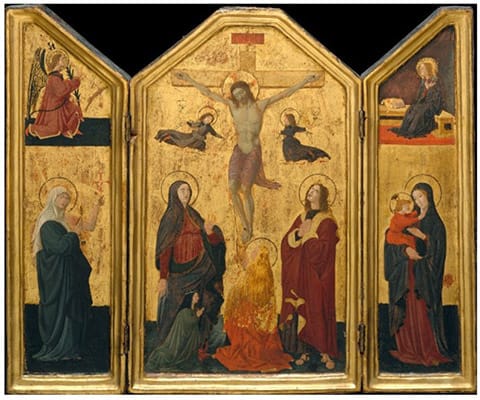
The Crucifixion
In this work, Uccello depicts the Crucifixion of Jesus, an eminent scene in art history by this point in time. Constructed in a three-panelled triptych, the artist includes many significant figures present at the Crucifixion as noted in the New Testament and of particular significance to the triptych's patron, Sister Felicity, a Bridgettine nun who lived at the convent, Santa Maria del Paradiso, close to Florence.
In the center panel, Christ is on the crucifix with the Virgin Mary standing to her son's right (our left). The work's current custodian, the Metropolitan Museum of Art, notes that the kneeling woman at the Virgin Mary's feet is likely Sister Felicity herself, for whom the work was made for her private devotional purposes. The woman in the white habit on the left panel is likely Saint Bridget of Sweden, the founder of the Bridgettine order of nuns and monks. Saint Bridget is also significant to the Crucifixion scene as she is known for having visions of Christ on the cross as a child (as well-as visions of the Nativity). The Nativity is in fact depicted in the right-hand panel in which the Virgin holds the infant Christ. The upper register of panels on both the right and left depict the Annunciation: the Angel Gabriel (on the left, winged, with red robes) tells the Virgin (seated in dark shroud on the right) that she would give birth to the Son of God. Depictions of the Virgin Mary and Christ featuring multiple times in a single work is not unusual in Early Renaissance artwork where asynchronous scenes were accepted practice.
Living and working in Florence most of his life, Uccello transferred some of the characteristics seen in other works. Notably, this work prioritizes symmetry. On each side of Christ, there is a figure on either side: two angels directly below his arms collect blood in chalices, the Virgin Mary and a male figure stand below. Two women kneel on either side of the cross: Sister Felicity the patroness and, likely, Mary Magdalene (who was also present at the Crucifixion in the New Testament). While these pairs of figures mirror one another, the figures do not appear to interact with one another. Rather, each gazes at Christ and acts in relation to his presence. This isolation from their surroundings demonstrates Uccello's choice to prioritize each figure's spiritual communication and connection to Christ.
Tempera on wood, gold ground - Metropolitan Museum of Art
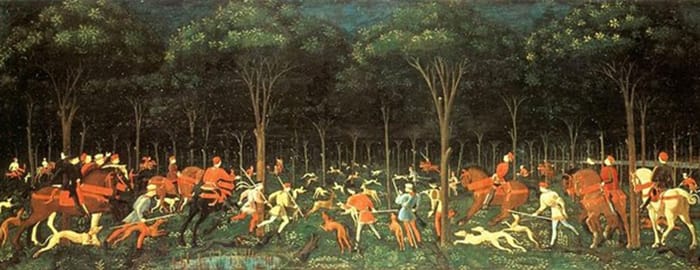
The Hunt in the Forest
Based on an unknown subject, but possibly a hunting outing by Lorenzo de' Medici, or even a passage from a contemporary novella, The Hunt in the Forest (usually referred to simply as The Hunt) is a masterclass in linear perspective and the artist's last known work. Uccello's frame is populous, featuring as it does, a large hunting party of aristocrats, servants, horses, hounds, and wildlife in the foreground, with a lush orchard hiding the skyline.
The scene is oriented toward a central vanishing point in the center of the forest, likely a singular tree with its branches reaching skyward. The vanishing point acts as an organizing force for the whole work, providing a logical focus towards which all the activity in the painting gravitates. From mounted aristocrats on horseback to hunting dogs, everyone is gravitating toward a singular point. Hunting spears and repeating tree motifs help to create a "grid-like" façade. Thematically, meanwhile, markings on the horse's trappings represent Diana, the Roman goddess of the hunt and the moon, highlighting the playfulness of the romping hounds, the lush earth, as well as the humanist faith in the ideals of Antiquity. The Ashmolean Museum posits that the painting was meant to be viewed at shoulder height, perhaps as a backboard of a decorated chest or set in the panelling of a room.
Like The Battle of San Romano (probably Uccello's most famous work) this scene focuses on a secular subject matter. Although Vasari was critical of the artist's choice not to conform to new standards of realism in Renaissance art, he did praise Uccello's talents as a landscape painter, noting that he was "the first of the older [i.e. earlier] artists, among the modern painters, to be famous for his landscapes". According to Vasari, Uccello was still a most highly regarded artist although sadly "he passed his life in these extravagancies, ending up as poor as he was famous".
Tempera and oil, with traces of gold, on panel - Ashmolean Museum, Oxford, England
Biography of Paolo Uccello
Childhood
Paolo Uccello was born in Pratovecchio around 1397 (Uccello's birth year is approximated based on tax records filed as an adult that state his adult age). It is known that the artist's parents married in 1387 and that Uccello's father, Dono di Paolo, was a barber and surgeon. Italian Renaissance chronicler Giorgio Vasari notes too that Uccello adopted the name due to his early love of painting birds and animals (uccello meaning "bird" in Italian) but little else is known of his early childhood.
Early Training
Although the exact dates cannot be confirmed, a young (not yet ten-years-old) Uccello was apprenticed to renowned Florentine artist and master sculptor, Lorenzo Ghiberti. Ghiberti's career defining work were the 10-panel bronze late-Gothic doors for the Baptistery of San Giovanni in the Florence Cathedral (installed in 1452). (As Arthur Lubow, writing for The Smithsonian, describes: "Michelangelo likened the gilded bronze doors [to] the 'Gates of Paradise.' The phrase stuck, for reasons that anyone who has seen them will understand. Combining a goldsmith's delicacy with a foundryman's bravura [Ghiberti] condensed the Old Testament into ten panels to produce one of the defining masterpieces of the Italian Renaissance".) As one might expect given such acclamation, Ghiberti's workshop was a hotbed for young talent and, in addition to Uccello, it would count Donatello and Masolino amongst its alumnus.
The historian John T. Paoletti writes that "In 1414 Uccello joined the confraternity of painters (Compagnia di San Luca), and in the following year he became a member of the Arte dei Medici e degli Speziali, the official guild in Florence to which painters belonged". Paoletti adds, however, that although Uccello "must by then have been established as an independent painter, nothing of his work from this time remains, and there is no definite indication of his early training as a painter". His first known works are in fact portrait medals; a style of miniature portraiture dating from the age of Classical Antiquity. Most of Uccello's medals were vanity commissions, but he also created paintings that celebrated the lives of Christian saints (hagiographic paintings). Indeed, Uccello's first recorded commission (for Lelmo Hospital) was Saint Anthony between the Saints Cosmas and Damianus (1424).
Between 1425 and 1431, Uccello worked in Venice as a mosaicist on a façade for Saint Marks which no doubt provided him with invaluable grounding for his later trials with color and light. Uccello interest in foreshortening, meanwhile, is attributed firstly to the influence of the architectural drawings of Filippo Brunelleschi, and the experiments of one of his friends and contemporaries, Masaccio, who had used linear perspective to striking effect in his masterpiece, The Holy Trinity (1427-28). Although his Venetian mosaics are now lost, Uccello's interest in mathematical proportions and linear perspective starts to become pronounced in his painting, St. George Slaying the Dragon (c. 1430).
Paoletti suggests that "Uccello may have been induced to return to Florence [from Venice] by the commission for a series of frescoes in the cloister of San Miniato al Monte depicting scenes from monastic legends" and that this series demonstrates the artist's growing "fascination with the novel perspective schemes that had appeared in Florence during Uccello's Venetian sojourn and with a simplified and more monumental treatment of forms deriving from the recent sculpture of Donatello and Nanni di Banco". Painted between 1432-36, Uccello's (now badly damaged) frescoes - which gave the cloister its name "Chiostro Verde" ("Green Cloister") because of the predominant green cast of the frescoes - showed Uccello's concern for linear forms and landscape patterning that would become typical of the late Gothic Florentine style during the fifteenth century.
Mature Period
By 1436, the Florence Cathedral, better known simply as the Duomo, was nearing its completion. The Office of Works (having approached the Florentine ambassador in Venice to inquire about Uccello's reputation as an artist in 1432) tasked Uccello with creating a fresco to honor one of Florence's late-fourteenth-century military heroes, the English mercenary Sir John Hawkwood. Uccello accepted the commission and proceeded to create a fresco that looked like an equestrian funerary monument employing the technique called terra verde (green earth) to replicate the real copper statute effect. Although never verified, it is widely thought that Uccello also painted the frescoes, Stories of the Virgin and Story of Saint Stephen, in the Cappella dell'Assunta, Prato around the same time - probably between 1435-40.
Between 1436-40 (though some have dated its completion as late as 1450), Uccello created what many consider to be his magnum opus, the triptych, The Battle of San Romano. It was owned by the powerful Florentine, Lorenzo de' Medici, who himself had acquired it from another influential Florentine family, the Bartolini Salimbeni. Although originally presented as a triptych, it is believed that the Medici separated the three panels to display them in the Palazzo Medici as wall tapestries. (Today, the three panels can be seen separately at the National Gallery in London, the Louvre Museum in Paris, and the Uffizi in Florence.) Each of the panels celebrate turning points from the Battle of San Romano, a significant battle in Florence's conflict with the Sienese concerning access to the strategic port of Pisa.
Paoletti writes, "These panels represent the victory in 1432 of Florentine forces under Niccolò da Tolentino over the troops of their archrival, Siena. There are Renaissance elements, such as a sculptural treatment of forms and fragments of a broken perspective scheme in this work, but the bright handling of colour and the elaborate decorative patterns of the figures and landscape are indebted to the Gothic style. The older style continued to be used through the 15th century in Florence to enrich the environments of the new princes of the day, such as the Medici".
In his analysis of the National Galley panel, meanwhile, art historian E. M. Gombrich writes: "Superficially the picture may look medieval enough. These knights in armour with their long and heavy lances, riding as if to a tournament, may remind us of a medieval romance of chivalry; nor does the way in which the scene is represented strike us at first as very modern. Both horses and men look a little wooden, almost like toys, and the whole gay picture seems very remote from the reality of war. But if we ask ourselves why it is that these horses look somewhat like rocking-horses and the whole scene reminds us a little of a puppet-show, we shall make a curious discovery. It is precisely because the painter was so fascinated by the new possibilities of his art that he did everything to make his figures stand out in space as if they were carved and not painted".
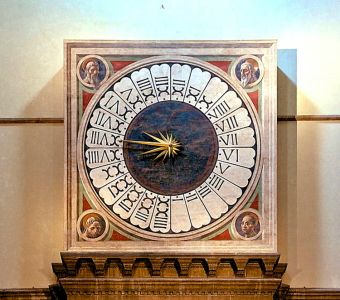
In 1443, Uccello painted four heads of prophets around a colossal clock on the interior of the west facade of the Duomo and, moving into 1444, designed two stained glass windows for the Duomo's cupola. Of his clock face, the Brazilian novelist and academic wrote: "In the cathedral in Florence, there's a beautiful clock designed by Paolo Uccello [...] The curious thing about this clock is that, although it keeps time like all other clocks, its hands go in the opposite direction to that of normal clocks. When he made this clock, Paolo Uccello was not trying to be original: The fact is that, at the time, there were clocks like his as well as others with hands that went in the direction we're familiar with now. For some unknown reason, perhaps because the duke had a clock with hands that went in the direction we now think of as the right direction, that became the only direction, and Uccello's clock then seemed an aberration, a madness".
Vasari records that Uccello was a timid, reclusive man, who became completely absorbed in his art. However, he appears to have maintained contact with fellow apprentices from Ghiberti's workshop and in 1445 Uccello travelled to Padua at Donatello's invitation. While there, Vasari suggests that the two men experimented with the terra verde technique.
On his return to Florence in 1446, Uccello painted a fresco in the Chiostro Verde of the Santa Maria Novella. The fresco illustrated scenes from the life of Noah. Vasari was especially impressed with Uccello's masterful treatment of "dead bodies, the storm, the fury of the winds, the bolts of lightning, trees breaking, and the fear of men". But the fresco is also widely admired for its exceptional foreshortening effects. As Paoletti writes, "Uccello presented two separate scenes united by a rapidly receding perspective scheme that reflected the influence of Donatello's contemporary reliefs in Padua", adding that "human forms in The Flood, especially the nudes, were reminiscent of figures in Masaccio's frescoes in the Brancacci Chapel (c. 1427)".
During the same period, Uccello painted the Green Stations of the Cross, once more for the cloister of the church Santa Maria Novella, and between 1447-54, Scenes of Monastic Life for the church San Miniato al Monte, Florence. In 1453, Uccello was married to Tommasa Malifici. In the same year Tommasa gave birth to a son, Donato (named after Uccello's friend, Donatello), and in 1456, a daughter called Antonia. (Antonia Uccello became a Carmelite nun, who Vasari referred to as the "daughter who knew how to draw". She is in fact recoded as a "pittessa" ("paintress") on her death certificate (dated 1491) although none of her works are thought to have survived her.)
Late Period
Uccello's triptych, The Crucifixion (c. 1455), was commissioned by a Brigitine convent, Santa Maria del Paradiso, near Florence. Included alongside traditional Crucifixion iconography is Sister Felicity, for whom the triptych was made for her private devotional purposes. This work carried all the hallmarks of Uccello's art: the use of linear perspective and an appearance for bright colors and gold in service of his subject. Sometime between 1465-69 Uccello was working in Urbino, with his son Donato, for the Confraternity of the Corpus Domini. He painted a six-panel tempera, the Miracle of the Profaned Host, for a predella and altarpiece but he was by now losing interest in his art and in life generally. In his Florentine tax return dated August 1469 the waning artist declared: "I find myself old and ailing, my wife is ill, and I can no longer work".
Returning finally to a secular subject matter, Uccello created a grand landscape in The Hunt in the Forest (c. 1465-1470). The scene is oriented toward a central vanishing point in the center of the forest, likely a singular tree with branches reaching skyward. From mounted aristocrats on horseback to hunting dogs, everyone is running toward this singular point. Vasari in fact praised his talents as a landscape painter, noting that he was "the first of the older [i.e., earlier Renaissance] artists, among the modern painters, to be famous for his landscapes". Uccello had by now become a reclusive, almost forgotten, figure. His last confirmed work was The Hunt (c. 1470) and he died on December 10, 1475. He is interred at his father's family grave in San Spirito, Florence.
The Legacy of Paolo Uccello
Grombrich writes: "While painters such as Fra Angelico could make use of the new without changing the spirit of the old [...] Uccello in his turn was completely captivated by the problems of the new". He adds that "The public probably liked masters [such as Fra Angelico] who gave them the best of both worlds [old and new]". Yet having completed important commissions for the court of the Medici, and frescoes for the Duomo, the more radical Uccello still enjoyed considerable fame during his own lifetime. He remained, nevertheless, a reclusive figure who devoted his time and energy to his studio experiments in perspective (with which he was likely assisted by the noted mathematician and astronomer, Paolo Toscanelli). According to Gombrich, indeed, Uccello's "fellow artists used to tell that he was so engrossed in these studies that he would hardly look up when his wife called him to go to bed and would exclaim: 'What a sweet thing perspective is!'". Indeed, his signature handling of perspective was such that it was influential on Renaissance treatises including those by artists of the stature of Piero della Francesca, Leonardo da Vinci, and the German, Albrecht Dürer.
Vasari adopted a somewhat diffident position toward the artist when he wrote: "the most captivating and imaginative painter to have lived since Giotto would certainly have been Paolo Uccello, if only he had spent as much time on human figures and animals as he spent, and wasted, on the finer points of perspective". But for Grombrich it was Uccello who did more than any other artist of his age "to show off the new effects which could be achieved by means of this magic [of perspective]".
Uccello's legend has been kept alive in nineteenth/twentieth century literature, too, through important works such as Marcel Schwob's collection, Vies Imaginaires (Imaginary Lives) (1896), which transformed Vasari's biography of "Paul of the birds" into what is often cited as a first in the genre of "historical fiction"; and the French avant-gardist Antonin Artaud's surrealist poem "Uccello le poil" ("Uccello the hair") (1926) in which he declared, "Blessed are you, you who had the rocky and earthly preoccupation of the depths".
Influences and Connections

-
![Filippo Brunelleschi]() Filippo Brunelleschi
Filippo Brunelleschi -
![Masaccio]() Masaccio
Masaccio -
![Leon Battista Alberti]() Leon Battista Alberti
Leon Battista Alberti - Nanni di Banco
- Masolino
-
![Donatello]() Donatello
Donatello - Paolo Toscanelli
-
![Donatello]() Donatello
Donatello - Masolino
 Ask The Art Story AI
Ask The Art Story AI














